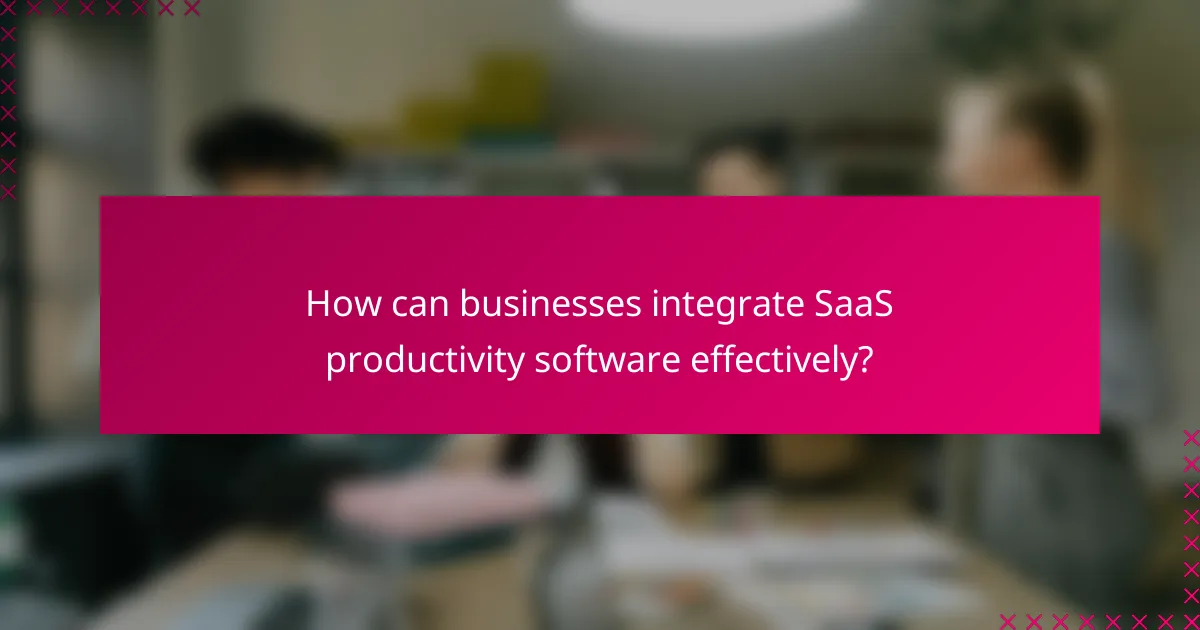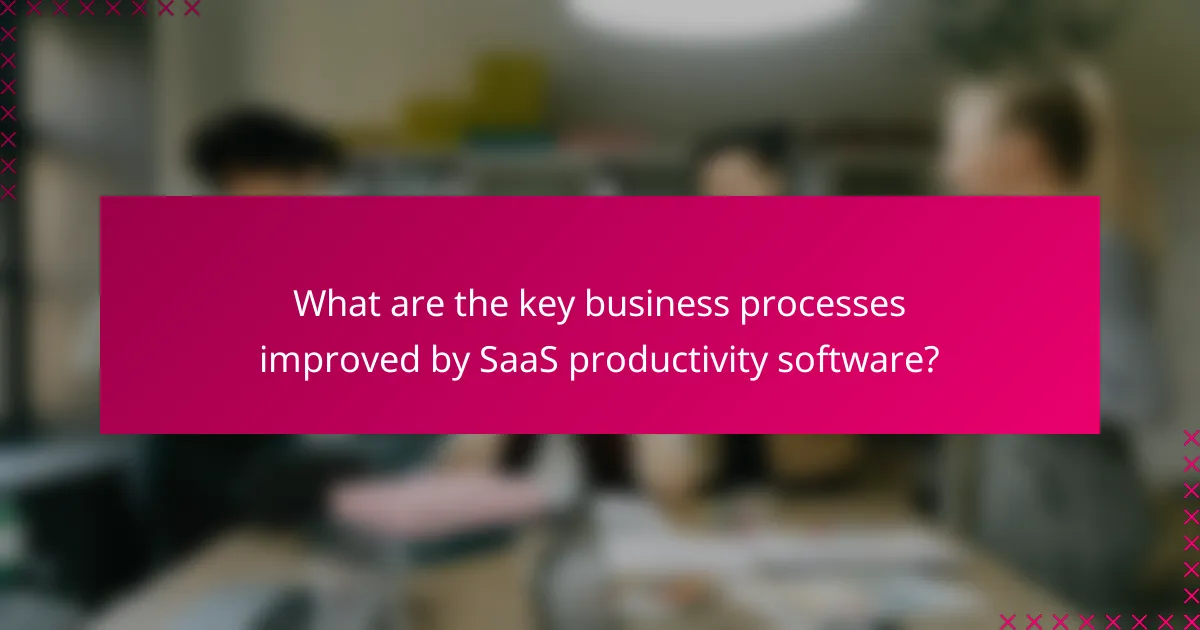SaaS productivity software offers Canadian businesses a range of tools designed to enhance project management, team communication, and workflow automation. By implementing best practices for integration, such as API connections and middleware solutions, organizations can streamline their operations and improve collaboration. These software solutions not only automate tasks but also provide real-time data access, significantly boosting overall efficiency and effectiveness in business processes.

What are the best SaaS productivity software solutions for businesses in Canada?
The best SaaS productivity software solutions for businesses in Canada include tools that enhance project management, task organization, team communication, workflow automation, and documentation. These solutions are designed to improve efficiency and collaboration while being adaptable to the unique needs of Canadian businesses.
Asana for project management
Asana is a powerful project management tool that helps teams organize, track, and manage their work. It allows users to create projects, assign tasks, set deadlines, and monitor progress through visual timelines and boards.
For Canadian businesses, Asana’s flexibility in project templates can be particularly beneficial for managing diverse projects across different industries. Consider integrating Asana with other tools like Slack or Google Drive to streamline your workflow.
Trello for task organization
Trello utilizes a card-based system to help teams organize tasks visually. Each card represents a task that can be moved across different stages of completion, making it easy to see the status of work at a glance.
This tool is especially useful for small to medium-sized Canadian businesses looking for a simple yet effective way to manage tasks. To maximize Trello’s potential, use labels and checklists to prioritize tasks and ensure nothing falls through the cracks.
Slack for team communication
Slack is a messaging platform designed for team communication and collaboration. It offers channels for different topics, direct messaging, and file sharing, making it easy for teams to stay connected.
For businesses in Canada, Slack can integrate with various productivity tools, enhancing communication efficiency. To avoid information overload, establish guidelines for channel usage and encourage team members to use threads for focused discussions.
Monday.com for workflow automation
Monday.com is a versatile platform that allows teams to automate workflows and manage projects efficiently. Users can customize boards to fit their specific processes, making it suitable for various business needs.
Canadian businesses can benefit from Monday.com’s automation features, which reduce repetitive tasks and save time. When implementing Monday.com, start with a clear understanding of your workflows to create effective automation rules.
Notion for documentation and collaboration
Notion is an all-in-one workspace that combines note-taking, task management, and database functionality. It allows teams to create and share documents, track projects, and collaborate in real-time.
This tool is particularly advantageous for Canadian businesses looking to centralize their documentation. To get started, create templates for common documents and encourage team members to contribute to shared pages for better collaboration.

How can businesses integrate SaaS productivity software effectively?
Businesses can integrate SaaS productivity software effectively by leveraging various tools and strategies that ensure smooth data transfer and user management. Key practices include using API integrations, implementing single sign-on, and utilizing middleware tools to automate workflows.
Use API integrations for seamless data flow
API integrations allow different software applications to communicate and share data effortlessly. By connecting SaaS tools through APIs, businesses can automate data entry, synchronize information, and reduce manual errors.
When considering API integrations, evaluate the compatibility of your existing systems and the SaaS platforms you plan to use. Ensure that the APIs are well-documented and supported, as this will facilitate smoother implementation and troubleshooting.
For example, integrating a project management tool with a time-tracking application can streamline reporting processes, allowing teams to focus on their tasks rather than administrative overhead.
Implement single sign-on for user management
Single sign-on (SSO) simplifies user management by allowing employees to access multiple SaaS applications with one set of credentials. This enhances security and user experience, as it reduces password fatigue and the risk of weak passwords.
To implement SSO, choose an identity provider that supports the applications your business uses. Ensure that the SSO solution complies with relevant security standards, such as SAML or OAuth, to protect sensitive information.
For instance, using SSO can significantly reduce the time spent on onboarding new employees, as they only need to remember one password to access various tools.
Utilize middleware tools like Zapier
Middleware tools like Zapier facilitate the integration of different SaaS applications without requiring extensive coding knowledge. These platforms allow users to create automated workflows, known as “Zaps,” that connect various apps and trigger actions based on specific events.
When using middleware, consider the volume of data and the frequency of updates required. While these tools can save time, they may introduce latency, so assess whether the trade-off is acceptable for your business needs.
For example, a Zap can automatically add new leads from a web form into a CRM system, ensuring that your sales team has immediate access to fresh data without manual entry.

What are the key business processes improved by SaaS productivity software?
SaaS productivity software enhances various business processes by automating tasks, improving communication, and providing real-time data access. Key areas of improvement include project management, team collaboration, and reporting capabilities, which collectively drive efficiency and effectiveness in operations.
Streamlined project management
SaaS productivity tools simplify project management by offering features like task assignment, deadline tracking, and resource allocation. These platforms allow teams to visualize project timelines through Gantt charts or Kanban boards, making it easier to identify bottlenecks and adjust plans accordingly.
For instance, using tools like Asana or Trello can help teams manage projects in real-time, ensuring everyone is on the same page. Establishing clear milestones and using automated reminders can further enhance project tracking and accountability.
Enhanced team collaboration
Collaboration is significantly improved through SaaS solutions that facilitate communication among team members. Features such as shared documents, instant messaging, and video conferencing enable teams to work together seamlessly, regardless of their physical locations.
Tools like Slack or Microsoft Teams provide centralized platforms for discussions and file sharing, reducing the need for lengthy email chains. Encouraging regular check-ins and using collaborative workspaces can help maintain engagement and foster a culture of teamwork.
Automated reporting and analytics
SaaS productivity software often includes built-in reporting and analytics capabilities that automate data collection and visualization. This allows businesses to generate reports on key performance indicators (KPIs) without manual effort, saving time and reducing errors.
For example, platforms like Google Analytics or Tableau can provide insights into user behavior and operational efficiency. Setting up automated dashboards and alerts can help teams stay informed about performance trends and make data-driven decisions quickly.

What are the best practices for implementing SaaS productivity software?
Implementing SaaS productivity software effectively requires careful planning and execution. Best practices include conducting a needs assessment, providing adequate training, and establishing clear goals and metrics to ensure alignment with business objectives.
Conduct a needs assessment before selection
A needs assessment helps identify the specific requirements of your organization before selecting SaaS productivity software. This process involves gathering input from various stakeholders to understand their challenges and expectations.
Consider factors such as current workflows, integration capabilities, and user experience. Prioritize features that address the most pressing needs and align with your business processes to maximize the software’s impact.
Provide training for team members
Training is crucial for ensuring that team members can effectively use the new SaaS productivity software. Develop a comprehensive training program that includes hands-on sessions, tutorials, and ongoing support to help users adapt.
Consider using a mix of training formats, such as live workshops and recorded sessions, to accommodate different learning styles. Regular check-ins and refresher courses can also help maintain proficiency and encourage engagement.
Establish clear goals and metrics
Setting clear goals and metrics is essential for measuring the success of your SaaS productivity software implementation. Define specific, measurable objectives that align with your overall business strategy, such as improving efficiency or reducing costs.
Utilize key performance indicators (KPIs) to track progress and make data-driven adjustments as needed. Regularly review these metrics to ensure that the software continues to meet your organization’s evolving needs and objectives.

What criteria should businesses consider when selecting SaaS productivity tools?
When selecting SaaS productivity tools, businesses should prioritize factors such as usability, integration capabilities, scalability, and cost-effectiveness. Evaluating these criteria ensures that the chosen software aligns with both current needs and future growth plans.
Scalability for future growth
Scalability is crucial for businesses anticipating growth, as it determines how well a SaaS tool can adapt to increasing demands. Companies should assess whether the software can handle a growing number of users, data, and features without significant performance degradation.
When evaluating scalability, consider the pricing model. Many SaaS providers offer tiered pricing based on usage or user count, which can be beneficial for managing costs as your business expands. Look for tools that allow easy upgrades or additional features that can be activated as needed.
Additionally, examine the provider’s track record for updates and enhancements. A scalable solution should not only support current operations but also evolve with emerging technologies and user requirements. Regular updates and a roadmap for future developments are good indicators of a provider’s commitment to scalability.
